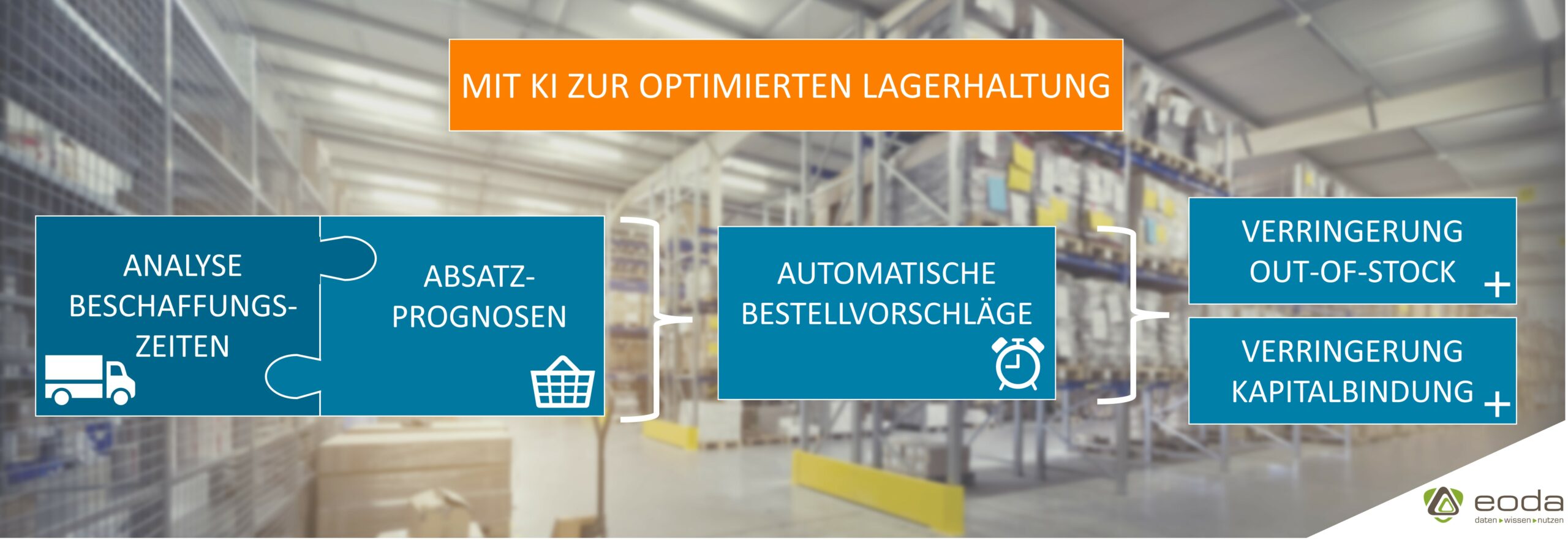Goal
Establishment of intelligent, data-driven inventory management to avoid out-of-stock situations and excessive capital commitment.
Solution
Automatic order recommendations based on sales forecasts and an analysis of replenishment times.
Special features
Very extensive range and sometimes spare parts needed at short notice.
Challenge
The company is a leading international supplier of spare parts and accessories for the mobility industry. The challenge for the company lies in its extensive product range of over 11,000 different spare parts and the need to deliver these to customers as quickly as possible when needed. The central control element is an inventory management system. Based on previously manually defined, static key figures, the system automatically provided purchasing with order suggestions when needed. Seasonal fluctuations and trends were not previously taken into account.
Goal
The customer wants to establish an intelligent, data-driven inventory management system. Specifically, this involves determining the ideal time to reorder items. To achieve this, seasonality and trends in particular need to be better and, above all, automated. This knowledge should help avoid out-of-stock situations and reduce capital tied up in the warehouse.
Solution
The company commissioned eoda's data science experts to implement the project.
To gain a better overview of the different characteristics of individual spare parts in relation to inventory behavior, eoda classified items with similar characteristics (fast-moving, medium-moving, slow-moving, etc.) using cluster analysis. These clusters and their different characteristics form the basis for the precise application of different algorithms when analyzing individual items.
Demand trends, stockouts, or the relationships between inventory and sales: eoda's descriptive analysis alone provided the customer with detailed insights into its product range. Compared to the existing information from the inventory management system, the customer has already realized initial added value in this early project phase.

eoda has combined two components to reliably determine the ideal reorder time:
- Sales forecast: Based on historical sales data, eoda has determined seasonal fluctuations and trends in the sales of individual products. Known usage cycles have also been incorporated into the sales forecast. Certain spare parts, such as batteries, have a limited useful life and make it likely that orders will be placed again after this known useful life has expired. Combining various key figures and influencing factors enables a more reliable forecast of the expected demand for spare parts.
- Replenishment lead time analysis: The second component relates to the replenishment processes. Here, eoda has determined the expected procurement times based on past orders and the corresponding date of goods receipt. Procurement time and the associated timely ordering are essential, especially for avoiding out-of-stock situations.
The customer's existing inventory management system provided all the data relevant for the analyses.
Upon completion of the project, the developed algorithms will be integrated into the productive procurement processes to continuously provide key performance indicators that optimally control the automatic order suggestions.
Result
With such an extensive product range, manual inventory optimization is virtually impossible. With the support of eoda and the use of data science, the customer was able to automate and improve its procurement processes, taking into account significantly more relevant influencing factors. The responsible purchasing staff thus receive notifications about necessary reorders in a much more needs-based and dynamic manner. This allows the company to better avoid its own supply bottlenecks and long-term overcapacity, thereby further increasing customer satisfaction and reducing procurement costs.
Get started now:
We look forward to exchanging ideas with you.

Your expert on Data-Science-Projects:
Lutz Mastmayer
projects@eoda.de
Tel. +49 561 87948-370